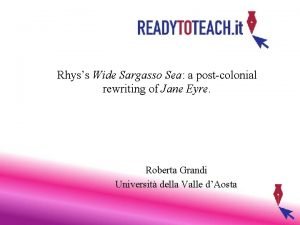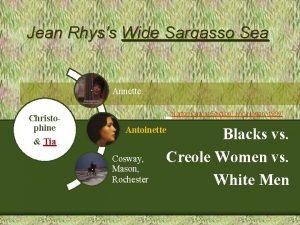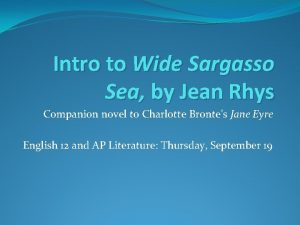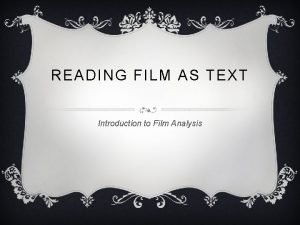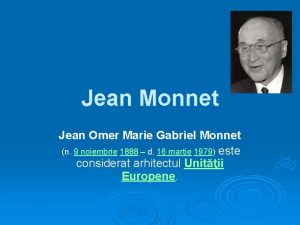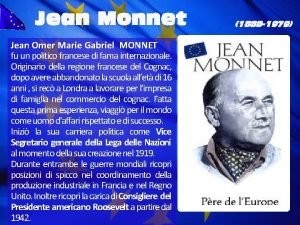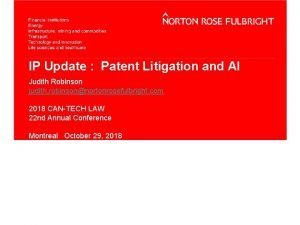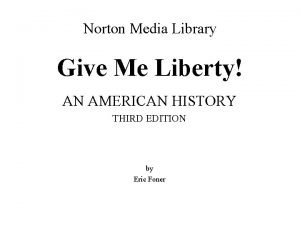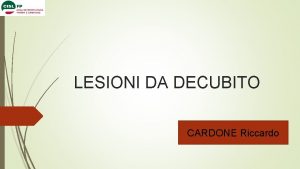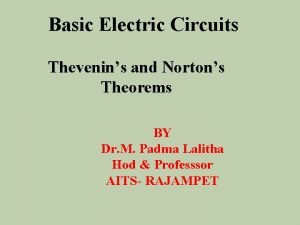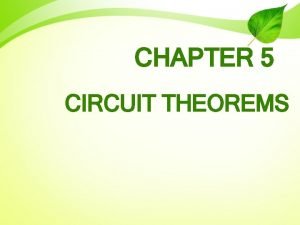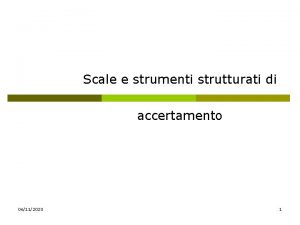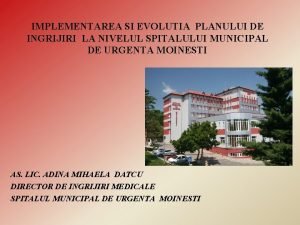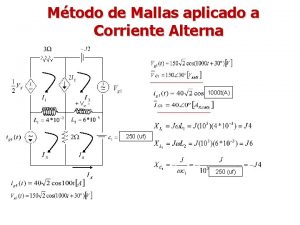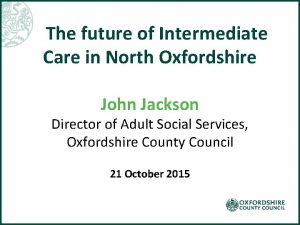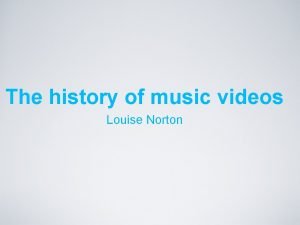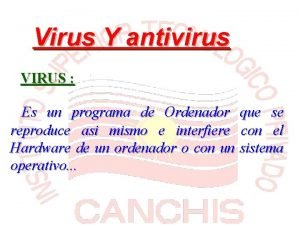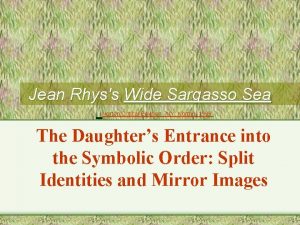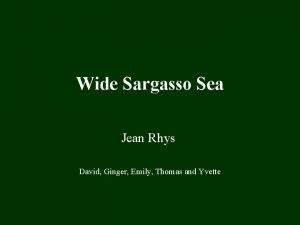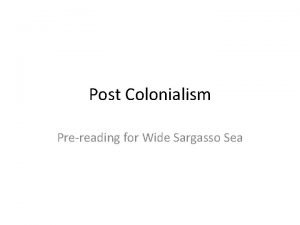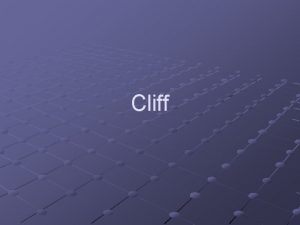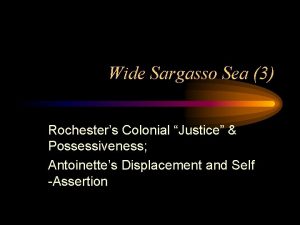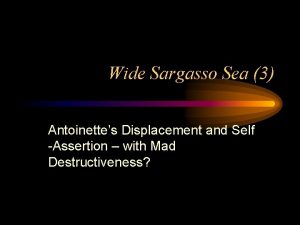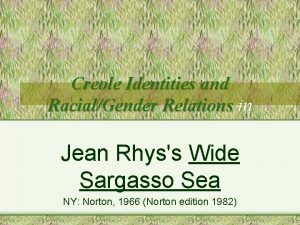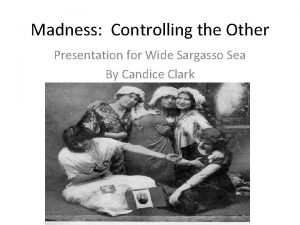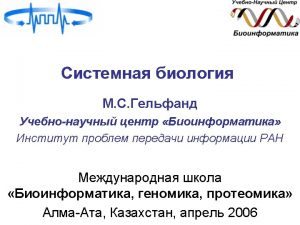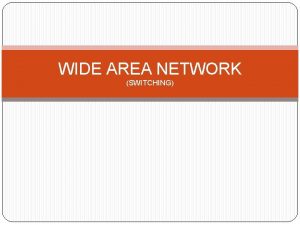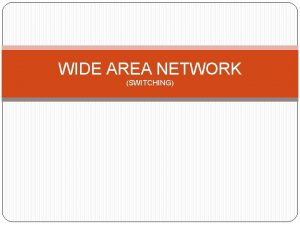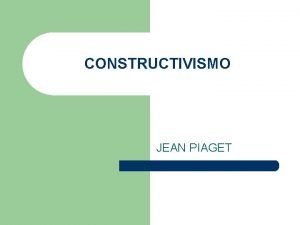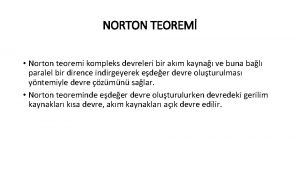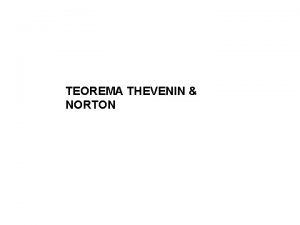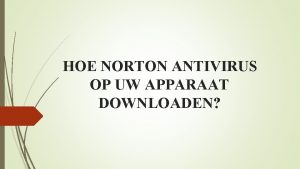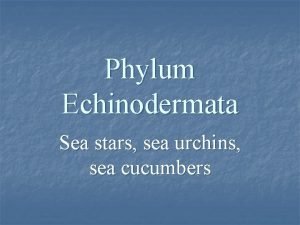Jean Rhyss Wide Sargasso Sea Norton Critical Ediction




































- Slides: 36

Jean Rhys's Wide Sargasso Sea Norton Critical Ediction. NY: Norton, 1999. Creole Identities, and Racial/Gender Relations

Outline • • • Jean Rhys Wide Sargasso Sea: General Introduction Part I: Antoinette’s personality and the causes for it 1) 2) 3) Annette: a) The Creole Identities of Annette; b) Annette as a Woman; c) madness Gender+Race Antoinette: a) loss of mother; b) as a creole; 3) convent Antoinette’s personality Part II: The problems in Rochester and Antoinette’s marriage 1) 2) 3) Race & Gender & marriage Good moments; Causes: a) cultural difference; 2) R’s racial prejudice; 3) R’s self -centeredness; 4) the letter; 5) A’s sense of doom; 6) C’s role

Jean Rhys--Biographical Sketch • 8/24/1890 the daughter of a Welsh doctor and a white Creole mother • 1907 -8 Attends the Perse School, Cambridge. • 1909 -10 Tours as a chorus girl. Abandoned by her lover. • 1919 Marries Jean Lenglet and moves to Paris. 29 Dec. , birth of a son who dies three weeks later. (–altogether 3 marriages, 2 children. )

Jean Rhys--Biographical Sketch • 1923 -24 Meets Ford Madox Ford. Husband in jail, affair with Ford. (ménage a trois--Ford, Stella Bowen, Jean)) • 1933 Divorce. • 1934 Marries Leslie Tilden-Smith. • 1945 TS dead. Begins work on Wide Sargasso Sea. • 1947 Marriage to Max Hamer. Disappears from the public scene. • 1966 WSS published.

Rhys: her characters’ and her self-identity • Her characters: , all drifting, unhappy, unstable, but with clear self-knowledge and understanding of others. – “I have no pride—no name, no face, no country. I don’t belong anywhere. ” (Good Morning, Midnight. ) • Rhys: Only returned to Dominica once in 56 years; • Rhys: . "I don't belong anywhere but I get very worked up about the West Indies. I still care. . "

Rhys: her self-identity • "Do you consider yourself a West Indian? " She shrugged. "It was such a long time ago when I left. " "So you don't think of yourself as a West Indian writer? " Again she shrugged, but said nothing. "What about English? Do you consider yourself an English writer? " "No! I'm not, I'm not! I'm not even English. " "What about a French writer? " I asked. Again she shrugged and said nothing. "You have no desire to go back to Dominica? " "Sometimes, " she said.

Wide Sargasso Sea: General Introduction – (1) the title • Sargasso Sea: The heart of the Bermuda Triangle is covered by the strangest and most notorious sea on the planet— the Sargasso Sea; so named because there is a kind of seaweed which lazily floats over its entire expanse called sargassum. (source) • signaling the wide division between Antoinette and Rochester and the race and gender entangled relationships in the Caribbean area.

FYI: Sargasso Sea • An oval-shaped area of the North Atlantic Sea, bordered by the Gulf Stream and encompassing Bermuda Islands. It is characterized by weak currents, ery little wind, and a free-floating mass of seaweed called Sargassum. (textbook 1)

Rhys on Jane Eyre • "The creole in Charlotte Bronte's novel is a lay figure -- repulsive which does not matter, and not once alive which does. . For me. . . she must be right on stage. She must be at least plausible with a past, the reason why Mr. Rochester treats her so abominably and feels justified, and the reason why he thinks she is mad and why of course she goes mad, even the reason why she tries to set everything on fire, and eventually succeeds. . . " (Gregg 82; emphases added) • Q: Is Anntoinette then doomed to be mad? Couldn’t there be different endings? Is the novel too sad?

Rhys's Revision of Jane Eyre: Shift of Dates: • Jane Eyre -- towards the end of the novel reads a book published in 1808 Bertha confined in the attic in the first decade of the 19 th century. • WSS's time frame shifted to 1830's onwards: Emancipation Act 1833 Antoinette – born 1839, a year after the full emancipation; a child in the 1840's (Mark Ma. Watt qut in Gregg 83)

Backgrounds (1) on Race: • I. white masters, New & Old: – Christophine’s comment 15 – Mr. Luttrells p. 17; death of Mr. Lutrell p. 26 – New masters after the Emancipation of slaves [Mr. Mason -- p. 32; p. 35] • II. White against creole – e. g. the town people’s gossip p. 17; Aunt Cora's husband 30 • III. Black against creole: – poor "white cockcroaches" p. 23; black Englishman, white niggers p. 25 • IV. The position of obeah woman p. 17.

Background (2): Before and after the Emancipation Pre-Emancipation: racial and sexual exploitation. (e. g. Daniel) Post-Emancipation Problems: 1. 2. 3. Belated Compensation, Importation of contract laborers Annette’s distrust of Christophine, Godfry, and Sass’ leaving p. 12 4. Riot: The presentation of the black mob Myra – hell (21); animal howling (p. 23), parrot killed = bad luck 25; the final confrontation, women crying 26.

WSS: Settings • Part I: (Martinique), Jamaica: Coulibri estate, near Spanish Town Part II: Granbois, Dominica, Part III: “Great House” England

Plot and Structure • Part I: Antoinette's Childhood – – – Isolation after Mr. Cosway’s death and the emancipation; The mother’s re-marriage to Mr. Mason; The riot; Antoinette in the convent. • Part II: Rochester and Antoinette – Upon arrival, R tries to adjust, writes letters to his father; relations between A & R. – Daniel’s letter and the letter from England. – Antoinette’s taking action – Leaving for England. • Part III: Antoinette in England

Characters •

Genealogy Cosway—Annette Alexander Daniel Pierre Sandi ----Antoinette—husband----Amèlie (Bertha) (Rochester) Christophine Tia

Central Questions • Part I: How does Rhys characterize Antoinette? What are the causes for her personalities? – Creole identity and Mother-daughter relationship; – childhood experience; – Convent education • Part II: How does Rhys explain the problems between Antoinette and Rochester? – their socio-historical context— 19 th Century Victorian/Colonial world? Race + Gender – Anything we can related to?

FYI: Important Symbols and Scenes Antoinette and Tia-- friendship (13 -14), divided by racial differences (27) • the garden imagery in Part I; • The fire scene and the burning of the parrot (25) • The two dreams (15, 35 -36)

Creole Women’s Positions: Annette: 1) multiple alienations of the creole —from the white people in the Spanish town (9; 17) —because she is Creole, from Martinique and poor; -- from the blacks (“they”) because she is former slave-owner and poor: pp. 10, 11 -- both Annette and Antoinette—seen as “white cockroaches” (13)/”white nigger” (14)

Creole Women’s Positions: Annette: -- 2) As a woman – a. Cosway: a womanizer; calls Daniel’s mother “sly boots” pp. 73 -74; halfway house p. 57 b. Widowed –can only survive by marrying again. Antoinette (solitary life) Antoinette (planned and hoped) p. 10 -- marooned & her son 11 -- borrow a horse from the new Lutrelles gay and a good dancer c. 2 nd Marriage: Worse, since Mason does not understand the racial relationship (19, 21)

Creole Women’s Positions: Annette: -- 3) as a creole woman a. Why does she care so much about the parorot Co. Co? 25 b. Antoinette’s account of what happened to Annette: 78 (also her sensual memories of the past 79); 80 -81

Creole Women’s Positions: Antoinette: (1) loss of motherly love • Her love rejected by Annette (11, 13, 15, 2829, ) • The mother cares more about Pierre 16; • Annette ashamed of her 15; • Being pushed away after her madness pp. 2829 • missing her mother in the convent 34; • The mother’s death 36

Creole Women’s Positions: Antoinette: (2) Race Relations – a. Christophine: helpful but fearful – – like a substitute mother; feared by Antoinette 18 -- Combination of Catholicism and voodoo Part II: 1. Antoinette’s seeking for help: p. 67, 68, 70 2. Put in jail once and may still be. P. 86)

Creole Women’s Positions: Antoinette and Tia – • friendship (13 -14), • divided by racial differences (27) b. The boy and the girl 29 -30

Creole Women’s Positions: Antoinette the second refuge in the convent –dissociated from reality – Stories of the saint; – no looking glass care taken in maintaining beautiful mages of femininity ; p. 32 -33; – images of the nations vs. the mother to be forgotten; 33 – A place of sunshine and of death. Pp. 33 -34

Creole Women’s Positions: Antoinette (& Annette) a. • • b. • Imagery: Garden the biblical myth of the garden--(11) associated with snake and forest Imagery: Mirror Annette 10; p. Antoinette & Tia; the convent

Antoinette’s personality: 5 examples 1. Self-protection in Childhood: e. g. the horse p. 10; garden 13; 16 2. Sense of danger in the recurrent dreams pp. 15, 27, 36 3. Attempt to turn down the marriage p. 46; 4. the two rats & the moon p. 49 – death impulse p. 54 Insecure; in lack of a firm sense of identity; (lack of love, fear of others’ and society’s criticism, feeling excluded. ) Fatalistic (fear of “madness” as a hereditary trait) childhood as a creole woman

Part II: What causes the problems between Antoinette & Rochester? Is Rochester completely to blame?

Sargasso Sea: Race and Gender • Why is the marriage between Rochester and Bertha unhappy? • Why is Bertha mad? Beast, madness in the family, driven mad, or not really mad? Gender – Marriage & Inheritance system Race White – Creole --Black Man Women Obeah woman

Gender/Race Relationships among the Character Mr. Cosway, Pierre Daniel Godfry Sass Myra Spanish Town Whites p. 17 Father The Masons E. Rochester Richard Aunt Cora p. 18, 68 -69 Annette Christophine • Antoinette Amelia

Good Moments in their relationship • Rochester’s sense of peace in nature P. 41 • Arrival at Granbois p. 42; • The first night 49 -50

Gender/Race Relations Women Unequal Relationships in Marriage • (about Mason’s marriage: p. 17) • Gender: Rochester’s Marriage and Inheritance: p. 41; 69 • “Dear Father” letters p. 39; But there are other factors. . .

What causes the problems between Antoinette & Rochester • 1. (Race) Cultural differences A. her limited understanding of the world --- p. 42 “Oh England, ” 56, 66 -67 -- p. 47 her “Paris”; ”Is it true, ' she said, `that England is like a dream? ” B. his illness and discomfort: p. 40, 41, blanks in his mind 45; p. 55 insecure

Part II: Causes for the conflicts between Rochester and Antoinette: 2. (Race) Rochester’s prejudice and racial superiority p. 39; p. 43 Rochester’s connection with the priest • the priest's ruined house--Pere Lilievre--Pere Labat pp. 62 -63; 83 3. Gender: Rochester's self-centeredness, possessiveness and pretentiousness • Agreed to everything 39; “not yet”; • not love her; perform and hide things p. 45, 61 • P. 55 watch her die many times • Turning Antoinette into Bertha pp. 68, 81

Part II: Causes for the conflicts between Rochester and Antoinette (2) 4. Race+ Gender: --or feminine madness as fate? • the letter from Daniel Rochester's suspicion of Antoinette’s madness (pp. 56 - ) • • Antoinette's temperament--sense of doom and insecurity Antoinette’s seeking for help from Christophine

For next time: The Turning Point 1. Are Christophine’s suggestions practical? pp. 65 -; – What stops her from being helpful? – Would their marriage have been saved without the voodoo? 2. Antoinette and her place –the crab, 52; 53; 3. The Ending – possibilities of ‘return’?
 Annette cosway
Annette cosway Annette wide sargasso sea
Annette wide sargasso sea Wide sargasso sea cliff notes
Wide sargasso sea cliff notes Critical semi critical and non critical instruments
Critical semi critical and non critical instruments Spaulding classification
Spaulding classification Wide shot camera
Wide shot camera Sargasso
Sargasso Pi·ha·hiʹroth
Pi·ha·hiʹroth Film as text
Film as text Jean monnet jean-gabriel monnet
Jean monnet jean-gabriel monnet Jean omer marie gabriel monnet
Jean omer marie gabriel monnet Hydra jellyfish
Hydra jellyfish Sea stack sea arch
Sea stack sea arch Marlin symbolism
Marlin symbolism Led soldiers across hellespont into anatolia goals
Led soldiers across hellespont into anatolia goals Yellow sea and east china sea
Yellow sea and east china sea Critical reading meaning
Critical reading meaning Worlds together worlds apart 4th edition
Worlds together worlds apart 4th edition Ivana gusar
Ivana gusar Seven essentials
Seven essentials Judith robinson norton rose
Judith robinson norton rose William b. norton
William b. norton Norton give me liberty
Norton give me liberty Maria ross norton rose
Maria ross norton rose Scala braden q pediatrica
Scala braden q pediatrica Norton theorem
Norton theorem Use source transformation to find io in the circuit
Use source transformation to find io in the circuit Scala di norton
Scala di norton Elaborarea planului de ingrijire
Elaborarea planului de ingrijire Tracy norton
Tracy norton Inredundante
Inredundante Edward norton lorenz
Edward norton lorenz Chipping norton war memorial hospital
Chipping norton war memorial hospital Louise norton
Louise norton Admission funda
Admission funda Suprepticio
Suprepticio Scala di norton
Scala di norton
